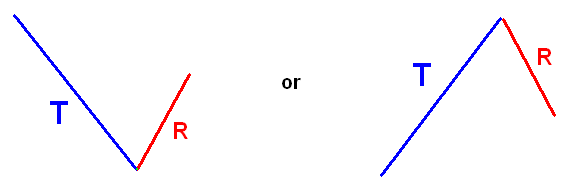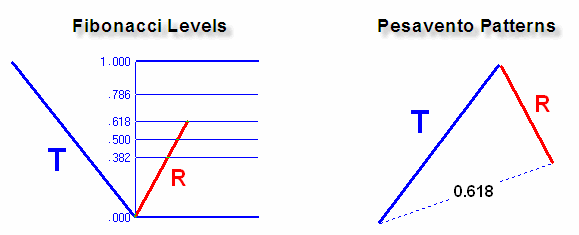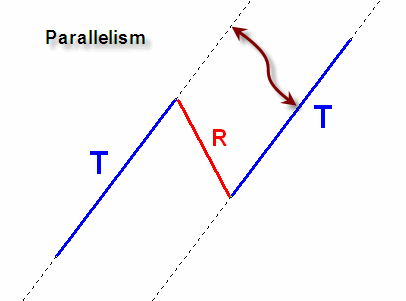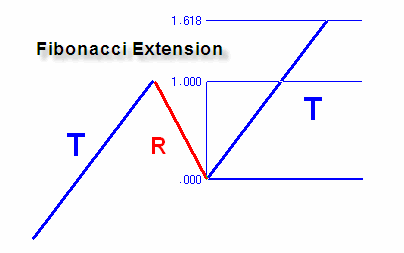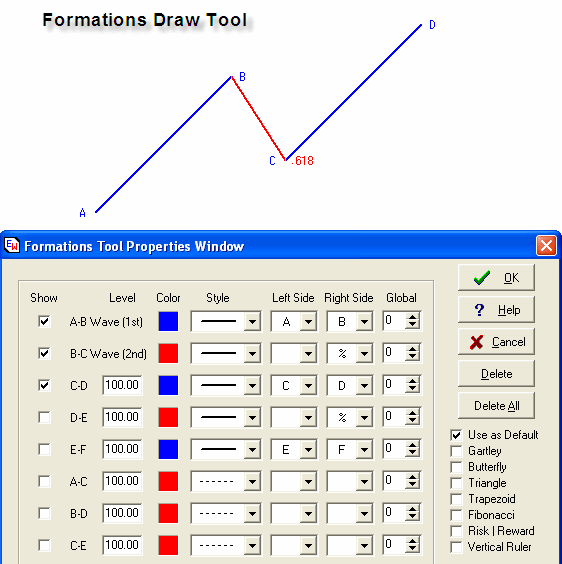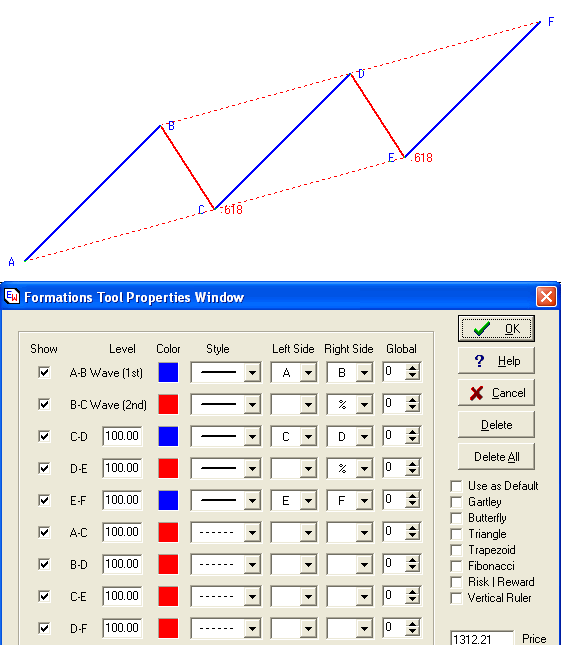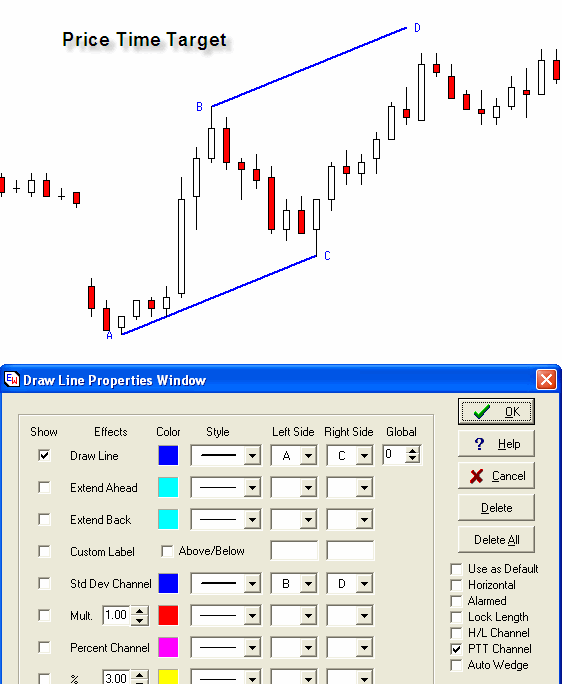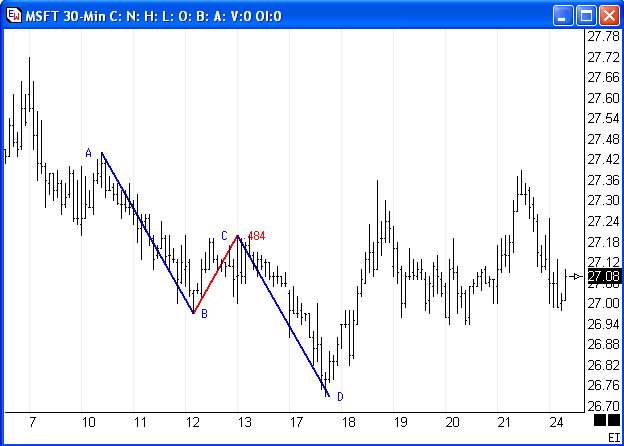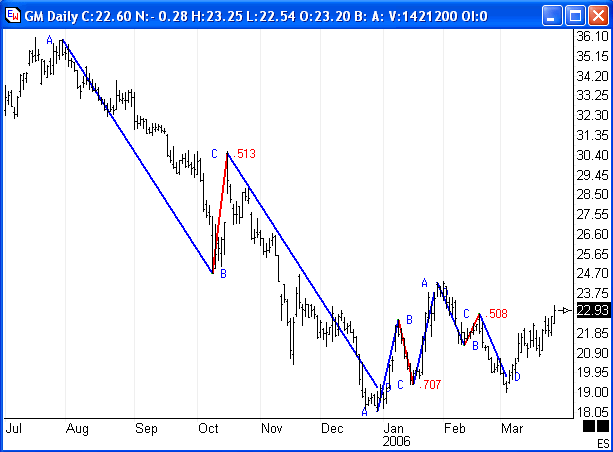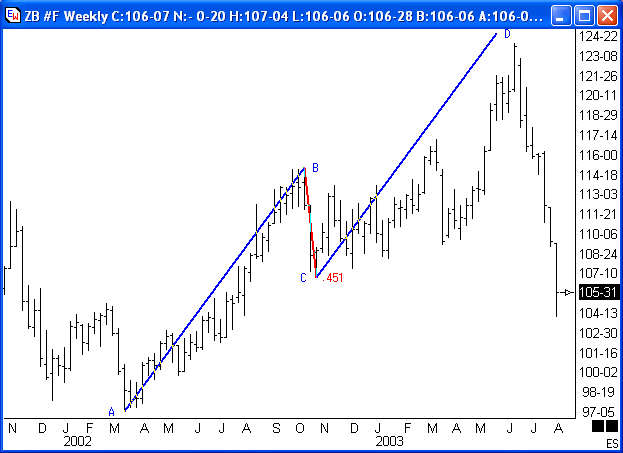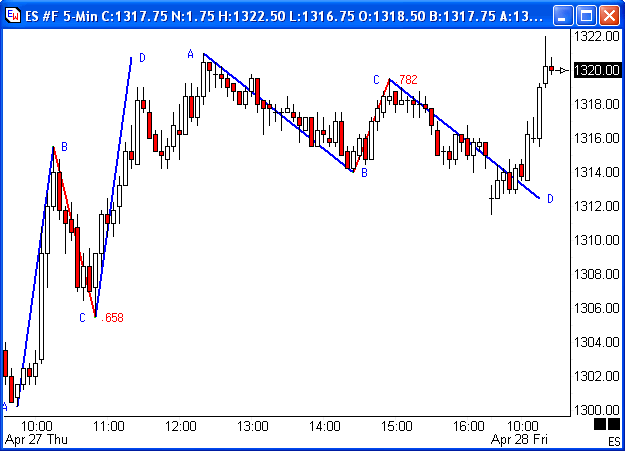by Howard Arrington As the tug-of-war ensues between buyers and sellers, chart patterns develop over a period of time. There are characteristics in these patterns that repeat with sufficient frequency that they need to be given serious study in your chart analysis. Because trading involves probabilities, not certainties, understanding and using market geometry can provide a statistical edge in trading profitably. All charts are drawn on a plane of rectangular (Cartesian) coordinates. There are two perpendicular lines that create a horizontal time based x-axis and a vertical priced based y-axis. The measure on the horizontal x-axis may be a fixed period of time, or a variable period of time because the bar duration is based on fixed units of volume or tick count. For additional information, read this excellent Trading Tips article on the Geometry of Charts. The patterns that develop contain transitions from one price to another. Major moves are called Trends, and corrective reactions to these trends are called Retracements. Trends will be referenced with the letter 'T' and Retracements with the letter 'R'. So, the simplest pattern would be the pairing of one Trend with one Retracement, ie. pattern T-R The basic pattern can be either of the follow shapes.
One characteristic of primary interest is the percentage of the trend's price change that is retraced by R. Two tools commonly used to measure and label the retracement percentage are the Fibonacci Levels and the Pesavento Patterns tools, as illustrated here. For more information, read this Trading Tips article on the Geometry of Draw Tools.
The most probable and useful retracement ratios are 0.618, followed by 0.786, and then 0.5. For greater insight on how Larry Pesavento uses these retracement ratios (percentages), read this Trading Tips article about Larry Pesavento. The next pattern to consider is the addition of a Trend to the basic pattern, ie. pattern T-R-T. This pattern will be the primary focus of this article because repeatable characteristics make it possible to predict WHEN and WHERE this second Trend move will end. Just remember that trading is dealing with probabilities, not certainties, but an advantage is gained by trading with probabilities that are in your favor. Parallelism - Parallelism is the single most
important and repeatable characteristic. It is seen over
and over again. It can be found multiple times on any
chart, and every chart. The principle is illustrated in
this diagram where the 2nd T line is parallel to the
1st T line.
Length - The length of the 2nd T line can be compared to the length of the 1st T line. The relationship with the highest probability is that the 2nd T line will be equal in length to the 1st T line. Some traders prefer to view the 2nd T as a percentage extension of prior R line, and the most common extension is the 1.618 multiple. Regardless of how you view the relationship, it is mathematically arriving at the same characteristic of a repeatable length. Consider the following. If R = 0.618 * 1st T, and 2nd T = 1.618 * R, then 2nd T = 1.618 * (0.618 * 1st T) = 1st T
A 2nd retracement and extension pairing is the 0.786 retracement and the 1.272 extension. This pairing also results in equal length T lines. Consider this relationship: If R = 0.786 * 1st T, and 2nd T = 1.272 * R, then 2nd T = 1.272 * (0.786 * 1st T) = 1st T Same Game, Different Name Each trading mentor seems to have a custom name for this basic T-R-T pattern. Some names in use are 'Lightning Bolt', 'AB=CD', 'Fibonacci Extension', 'Pesavento Patterns', 'Price Time Target', 'Elliott Wave a-b-c or 1-2-3'. Two tools in Ensign Windows are handy for forecasting the WHEN and WHERE for the completion of the 2nd T line once the 1st T and R moves are completed. The first tool shown is the Formations draw tool with its properties window.
The tool is manually applied to the chart by clicking the left mouse button down at point A, hold the button down and drag to point B, release the mouse button, move to point C and click the left mouse button. The tool will draw the lines shown, which gives a forecast of point D by making line CD both parallel and equal in length to line AB. The tool is customizable for colors, line styles, and markers to label the left and right sides of the lines. The length relationship of CD in comparison to AB is a customizable parameter. In the example, the relationship is set to 100 which means the length of line CD is 100% of the length of line AB. The Formations tool can be used to show other variations, such as adding lines to forecast point E and point F. Line DE is parallel to line BC and has a length relationship to line BC entered as the Level parameter on the D-E property line. Line EF is parallel to line AB and has a length relationship to line AB entered as the Level parameter on the E-F property line. The Show boxes can be checked to draw lines connecting points A to C, B to D, C to E, and D to F as illustrated in the following picture.
Another draw tool that creates the same forecast to point D is the straight line draw tool with its PTT (Price Time Target) Channel property checked. The tool is applied to the chart by clicking down on point A, hold the button down and drag to point C, and release the left mouse button. The tool will automatically find point B which is a swing point between A and C, and draw the BD line both parallel and equal in length to line AC from point B.
Although the PTT Channel construction technique is slightly different, point D is the same forecast point as illustrated in the prior example constructed with the Formations tool. Points ABCD form a parallelogram with the following characteristics. AB is parallel to CD and AB=CD. AC is parallel to BD and AC=BD. Example Charts
The ability to forecast WHEN and WHERE the 2nd Trend line will complete gives you a statistical advantage in your trading. It enables you to have increased confidence that a trend has matured by completing its time and price objectives. Don't overlook this gem of a Trading Tip, because it is one of the best ones that can be shared with you. It is used by successful traders. Training Tip: Ensign Software's web site has a collection of Training Videos on a variety of topics, including Fibonacci Levels, Pesavento Patterns, Gartley / Butterfly Patterns, Formations Tool and Pivot Points. These training videos provide additional information related to the material presented in this issue of the Trading Tips newsletter. To watch these 3 to 20 minute videos, go to the Ensign web site, click on the Videos button, click on any of the links in the section for the Training Videos. The videos will play in your web browser viewer. Please check them out. The web site URL is: |
